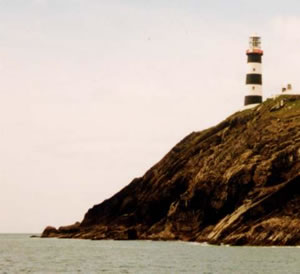Old Head of Kinsale Lighthouse.
The Old Head of Kinsale lighthouse is situated at the very tip of the Old Head Peninsula. It's geology is Classier bedded sandstone and minor mudstone. It's position is...
|
Navigation Aids:-
- LIGHT:
Group Flashing (2) White every 10 seconds.
Intensity of 792,000 candelas.
Nominal Range of 25nm
Height above MHWS of 236 ft (72m) - RADIO Beacon
Morse 'OH' 3 times for 15 seconds followed by a long dash lasting fore 45 seconds
288.0 KHz
50 nm range - FOG HORN
Electric
Three (3) blasts every 45 seconds
Range 3.9nm (both emitters)
HISTORY.
There have been references to a beacon of some form at the Old Head in Pre-Christian Times. However, the first lighthouse proper here was built in 1665. It was one of six built around the Irish coast by a Sir Robert Reading. and consisted basically of a cottage with a coal-fired chauffer or brazier on it's roof for lighting. Service was poor and caused many complaints.
|
||||||||||||||||||||||||||||||||||||||||||||||
WRECKS.
The Old head has had it's share of wrecks. Below is a list that we hope to add to in time...details we mean!!
Boadicea 30-Jan-1816. A brig, struck the Curlane rocks, (between Garrylucas and Garretstown). She was returning soldiers from the Battle of Waterloo to serve garrison duty at Cork. The ship was quickly ripped apart in the storm with the loss of almost the entire compliment of soldiers and crew. The bodies were quickly buried on the beach but were later exhumed and re-interred at Old Court churchyard at the base of the Old Head.
Lord Melville 30-Jan-1816. A former East-India ship of 818 tonnes, she struck rocks 300 yds off the Old Head of Kinsale. A boat was launched but was almost immediately swamped with the loss of it's 12 crew. The ship remained intact until all the remaining crew had been saved by the lighthouse keepers. HMS Stillorgan
16-Jun-1778. A 90 gun ship of the line was driven by a storm onto the Bream Rock where it quickly broke up. City of Chicago 22-Jun-1892. The 3360 ton Inman liner struck and became wedged in the cliffs below the Old Head of Kinsale lighthouse. The captain kept the engines at Slow Ahead to keep the stricken liner from falling back into deeper waters. After 3 days all passengers, luggage and whatever could be saved had been taken off. Today much of the steel plate-work can be found at about 60 ft strewn about an area of approx. 300' x 100'. We are always happy to bring diving teams to the wreck locations. References: Journal of the Cork Historical Society, Vol 8, 53-55, 1902,
Journal of the Cork Historical Society, Vol 7, 43-46, 1901,
Shipwrecks of the Irish Coast, Vol 1 and Vol 2,
Eddie Lyons of the Cork Archives.
National Maritime Museum, Dun Laoighre,Co.Dublin, 01-2800969


